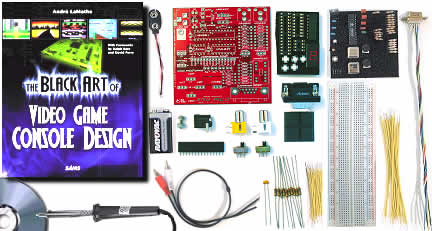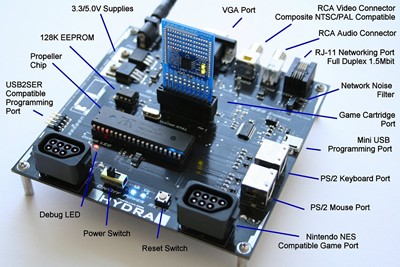
| Energy in Nature | Inventors & Inventions | Workbench Fun | Physics Lab |
|
Consumer Products | Computers | Automation & Robotics | What's in the Future |
|
XGameStation review As an admitted electronics geek I still remember my odd - some would say antisocial :-) - behavior back in the 80's. My friends and I would always go out on the weekends to either see a live band or just have a good time after the work week. This was the era of Pac-Man, Defender, and Donkey Kong, and I would always find myself gravitating towards these machines - not to play them but to stare at the animated graphics and try to imagine the circuitry and lines of code that would generate this cool stuff. The idea of trying to backward-engineer one of these arcade systems, or even a consumer level console, was a little intimidating though. Also, this was a very competitive time for the computer game industry so system designers and programmers were generally pretty tight-lipped about their work. These factors combined to keep my interest to just a curiosity throughout this period. Andre' LaMothe, a computer scientist and prolific author on the subject, recognized a need to help enthusiasts learn these skills from the ground up, and developed a project kit called the XGameStation. It combines a choice of several different hardware boards with comprehensive how-to documentation and an IDE (integrated development environment) to program and write games with. Basically it's everything you need to learn, create, and play your own video games with. It's also a very fun way to learn the fundamentals of computer science, whether to satisfy your curiosity about gaming or to prepare for a career in this business, Information Technology, or the automation industry. When I saw this product on the market I contacted Nurve Networks LLC, the makers of this product, to get more information in order to write this article. Below are some of the details. You can also visit thier web site: XGameStation.com.
Thier web site states it this way: "Imagine understanding how video game systems are designed and developed at an engineer's level. Imagine writing your own games for a piece of hardware you're personally capable of building. This isn't a field trip to the factory -- this is decades of video game hardware development boot camp compressed into a single product designed to upgrade your brain and take you to the next level of skill and understanding. It was estimated that only 100-200 people on the entire planet understood the workings of the legendary Atari 2600 and its design. What if you could design machines like this and beyond?" If you're just curious like me, or you want to gain a comprehensive knowledge of the nuts and bolts of gaming and computer systems, these kits are a very fun way to go!
Paul Huber |
Home | About Us | Advertise | Submit an Article | Submit a Link | Contact Us
Copyright © 2006 electricalfun.com - All rights reserved
 This
is the Game Console Starter Kit. According to Nurve it is the best
way to get started. You assemble the hardware yourself, and they
provide both a solderless breadboard for testing and experimentation
as well as a printed circuit board for a permanent finished product.
The kit also includes Andre' LaMothe's "The Black Art of Video Game
Console Design" book as well as the softwawe and documentation you
will need. Although based on a simpler microcontroller, it still has
plenty of power to program and play fast paced and detailed video
games. The Ubicom SX28 (80MHz.) comes with a pre-loaded demo
game and is programmable in Assembly or Basic using the development
software.
This
is the Game Console Starter Kit. According to Nurve it is the best
way to get started. You assemble the hardware yourself, and they
provide both a solderless breadboard for testing and experimentation
as well as a printed circuit board for a permanent finished product.
The kit also includes Andre' LaMothe's "The Black Art of Video Game
Console Design" book as well as the softwawe and documentation you
will need. Although based on a simpler microcontroller, it still has
plenty of power to program and play fast paced and detailed video
games. The Ubicom SX28 (80MHz.) comes with a pre-loaded demo
game and is programmable in Assembly or Basic using the development
software. This
is the XGameStation Micro Edition. This one is fully assembled,
ready to use, and features the more sophisticated Ubicom SX52. Like
the Starter Kit it also includes the development software you will
need to program games of your own design. Included eBook
publications are: Andre' LaMothe's "Designing Your Own Video Game
Console" and "Tricks of the Windows Game Programming Gurus" as well
as Parallax's "Beginning Assembly Language for the SX
Microcontroller". There is also a Printed copy of the "XGS Micro
Edition User Guide". As you can see in the photo it also includes an
Atari style joystick, A/V cables, power supply, and serial cable for
connection to a development PC.
This
is the XGameStation Micro Edition. This one is fully assembled,
ready to use, and features the more sophisticated Ubicom SX52. Like
the Starter Kit it also includes the development software you will
need to program games of your own design. Included eBook
publications are: Andre' LaMothe's "Designing Your Own Video Game
Console" and "Tricks of the Windows Game Programming Gurus" as well
as Parallax's "Beginning Assembly Language for the SX
Microcontroller". There is also a Printed copy of the "XGS Micro
Edition User Guide". As you can see in the photo it also includes an
Atari style joystick, A/V cables, power supply, and serial cable for
connection to a development PC. Thier
newly released "Hydra" system uses Parallax Inc.'s new
multi-processing "Propeller Chip". With 8 independent processing
cores, and basic graphics hardware support built in, this system
offers the best performance and flexibility, yet still maintains
enough simplicity to be fully understood by the user. This is
critical to building a solid foundation of knowledge without having
to guess at abstract layers of hardware and software - as you would
with an Xbox or PS2/3. Unlike the other two kits this one rises to
the level of a complete computer system. It includes not only more
functional Nintendo NES type game ports, but USB, RJ-11 network, and
PS/2 keyboard and mouse ports as well as the actual mouse and
keyboard units. Centered on the circuit board is also a game
cartridge port to allow the convenience of easily swapping out
different game or program software cards (1 card is included).
Thier
newly released "Hydra" system uses Parallax Inc.'s new
multi-processing "Propeller Chip". With 8 independent processing
cores, and basic graphics hardware support built in, this system
offers the best performance and flexibility, yet still maintains
enough simplicity to be fully understood by the user. This is
critical to building a solid foundation of knowledge without having
to guess at abstract layers of hardware and software - as you would
with an Xbox or PS2/3. Unlike the other two kits this one rises to
the level of a complete computer system. It includes not only more
functional Nintendo NES type game ports, but USB, RJ-11 network, and
PS/2 keyboard and mouse ports as well as the actual mouse and
keyboard units. Centered on the circuit board is also a game
cartridge port to allow the convenience of easily swapping out
different game or program software cards (1 card is included).